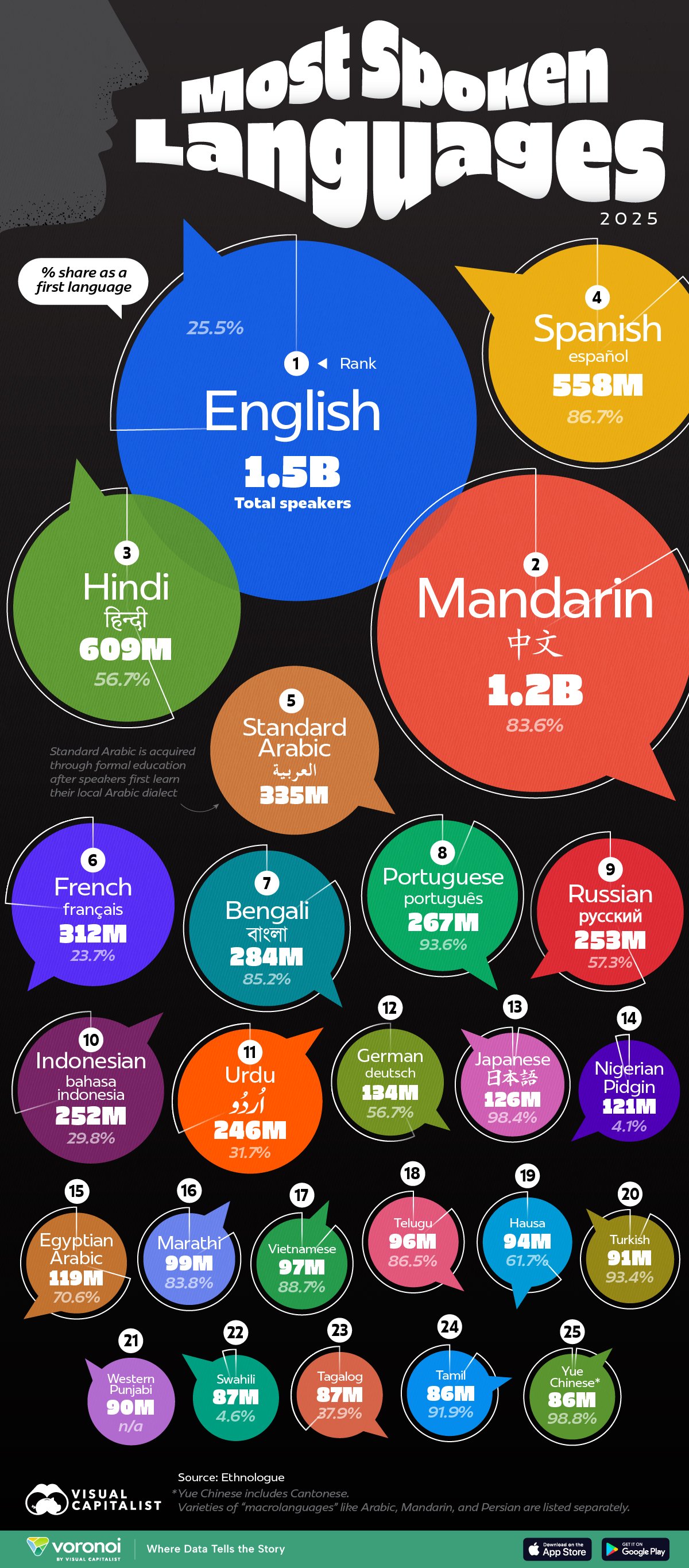Ranked: The World’s Most Spoken Languages in 2025
This was originally posted on our Voronoi app. Download the app for free on iOS or Android and discover incredible data-driven charts from a variety of trusted sources.
Key Takeaways
- English is the most spoken language in 2025 with 1.5 billion total speakers.
- About 25% (390 million) speak English as a first language, but a staggering 1.1 billion use it as their second language.
- Second-ranked Mandarin has 1.2 billion speakers but the first and second language split is reversed.
The world has never been more connected, and our linguistic map reflects that reality.
This visualization ranks the 25 languages with the largest total number of speakers in 2025, combining first and and second-language usage.
The data for this visualization comes from Ethnologue.
Ethnologue lists dialects separately instead of grouping them under a “macrolanguage.” This can lower totals for languages with many subdivisions (e.g., Chinese, Arabic, Punjabi, Swahili).
 A “macrolanguage” is a group of closely related languages or dialects that are sometimes treated as a single language for certain purposes, like in library cataloging, while being treated as separate languages in other contexts, like in linguistic research.
A “macrolanguage” is a group of closely related languages or dialects that are sometimes treated as a single language for certain purposes, like in library cataloging, while being treated as separate languages in other contexts, like in linguistic research.English’s Global Reach Relies as a Second Language
English remains the undisputed lingua franca, but its lead is built on adoption rather than birth.
| Rank | Language | Total Speakers (In millions) |
First Language | Share of First Language |
Second Language |
|---|---|---|---|---|---|
| 1 |     English English |
1,528 | 390 | 25.52% | 1,138 |
| 2 |    Mandarin Mandarin |
1,184 | 990 | 83.61% | 194 |
| 3 |  Hindi Hindi |
609 | 345 | 56.65% | 264 |
| 4 |   Spanish Spanish |
558 | 484 | 86.74% | 74 |
| 5 |   Standard Arabic Standard Arabic |
335 | 0* | 0% | 335 |
| 6 |   French French |
312 | 74 | 23.72% | 238 |
| 7 |   Bengali Bengali |
284 | 242 | 85.21% | 43 |
| 8 |   Portuguese Portuguese |
267 | 250 | 93.63% | 17 |
| 9 |  Russian Russian |
253 | 145 | 57.31% | 108 |
| 10 |  Indonesian Indonesian |
252 | 75 | 29.76% | 177 |
| 11 |   Urdu Urdu |
246 | 78 | 31.71% | 168 |
| 12 |  German German |
134 | 76 | 56.72% | 58 |
| 13 |  Japanese Japanese |
126 | 124 | 98.41% | 2 |
| 14 |  Nigerian Pidgin Nigerian Pidgin |
121 | 5 | 4.13% | 116 |
| 15 |  Egyptian Arabic Egyptian Arabic |
119 | 84 | 70.59% | 35 |
| 16 |  Marathi Marathi |
99 | 83 | 83.84% | 16 |
| 17 |  Vietnamese Vietnamese |
97 | 86 | 88.66% | 11 |
| 18 |  Telugu Telugu |
96 | 83 | 86.46% | 13 |
| 19 |    Hausa Hausa |
94 | 58 | 61.70% | 36 |
| 20 |  Turkish Turkish |
91 | 85 | 93.41% | 6 |
| 21 |  Western Punjabi Western Punjabi |
90 | Not reported | n/a | Not reported |
| 22 |   Swahili Swahili |
87 | 4 | 4.60% | 83 |
| 23 |  Tagalog Tagalog |
87 | 33 | 37.93% | 54 |
| 24 |  Tamil Tamil |
86 | 79 | 91.86% | 8 |
| 25 |   Yue Chinese Yue Chinese |
86 | 85 | 98.84% | 1 |
Note: *Standard Arabic is taught in schools, after a child has learnt their local Arabic dialect.
Only one in four English speakers learn it as a first language. The remaining 1.14 billion learned it for business, education, or entertainment.
This 75% share of second-language speakers illustrates how institutional support—from universities to social media platforms—keeps expanding English’s footprint.
In short, proficiency in English unlocks global opportunities, so demand feeds on itself.
Mandarin and Spanish Dominate Language Lists
By contrast, Mandarin’s 990 million first-language speakers make up 84% of its total. This Reflects China’s enormous population and Mandarin’s comparatively limited diffusion abroad.
Spanish follows a similar pattern: 87% of its 558 million speakers learned it at home, concentrated across Latin America and Spain.
These figures underscore that large population bases, not international adoption, anchor Mandarin and Spanish near the top of the rankings.
The Rise of South Asian and African Languages
Also on the list of most spoken languages in 2025: Hindi (609 million speakers) and Bengali (284 million) highlight South Asia’s demographic boom, while Urdu’s 246 million users span Pakistan, India, and a far-flung diaspora.
Meanwhile, Swahili and Nigerian Pidgin showcase Africa’s linguistic dynamism. Each has fewer than 10 million first-language speakers, yet exceeds 80 million total thanks to regional trade and media.
 As Swahili is a macrolanguage, this number is for Tanzanian Swahili speakers only.
As Swahili is a macrolanguage, this number is for Tanzanian Swahili speakers only.As these economies grow, their languages may follow English’s path—moving from local bridge tongues to global assets.
Learn More on the Voronoi App 
If you enjoyed today’s post, check out Which Language Every Country Wants to Learn on Voronoi, the new app from Visual Capitalist.
















